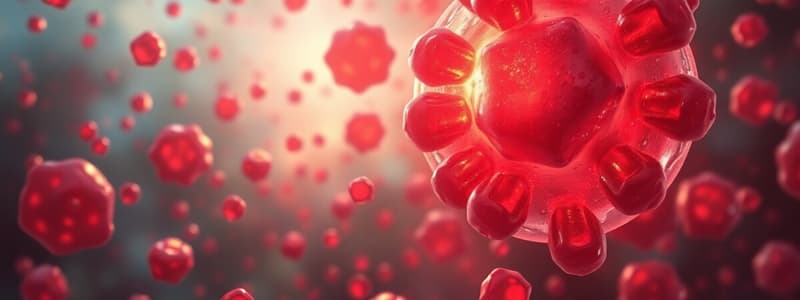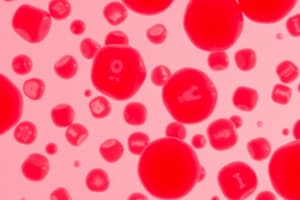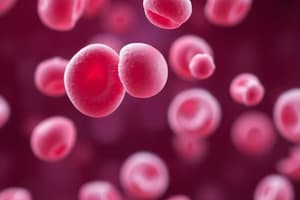Podcast
Questions and Answers
Which of the following is a morphologic hallmark of macrocytic anemia?
Which of the following is a morphologic hallmark of macrocytic anemia?
- Target cells
- Spherocytes
- Megaloblasts with nuclear-cytoplasmic dyssynchrony (correct)
- Schistocytes
What is the primary cause of pernicious anemia?
What is the primary cause of pernicious anemia?
- Folate deficiency
- Autoimmune destruction of parietal cells (correct)
- Iron deficiency
- Chronic blood loss
Which of the following is a common clinical manifestation of Vitamin B12 deficiency?
Which of the following is a common clinical manifestation of Vitamin B12 deficiency?
- Neurologic damage (demyelination) (correct)
- Clubbing of fingers
- Hypertension
- Peripheral edema
A patient presents with fatigue, pallor, and glossitis. Lab results show a high methylmalonic acid level. Which anemia is most likely?
A patient presents with fatigue, pallor, and glossitis. Lab results show a high methylmalonic acid level. Which anemia is most likely?
Which of the following is a typical treatment for folate deficiency anemia?
Which of the following is a typical treatment for folate deficiency anemia?
A patient with a history of alcoholism is diagnosed with anemia. Which of the following is the most likely cause of their anemia?
A patient with a history of alcoholism is diagnosed with anemia. Which of the following is the most likely cause of their anemia?
What distinguishes folate deficiency anemia from vitamin B12 deficiency anemia in terms of neurological symptoms?
What distinguishes folate deficiency anemia from vitamin B12 deficiency anemia in terms of neurological symptoms?
Which type of anemia is most prevalent?
Which type of anemia is most prevalent?
What is a common clinical manifestation uniquely associated with iron-deficiency anemia?
What is a common clinical manifestation uniquely associated with iron-deficiency anemia?
Which laboratory finding is characteristic of iron-deficiency anemia?
Which laboratory finding is characteristic of iron-deficiency anemia?
A patient is diagnosed with sideroblastic anemia. Which of the following is a potential cause?
A patient is diagnosed with sideroblastic anemia. Which of the following is a potential cause?
What is the underlying mechanism in sideroblastic anemia?
What is the underlying mechanism in sideroblastic anemia?
What is a key diagnostic finding in sideroblastic anemia?
What is a key diagnostic finding in sideroblastic anemia?
Which type of anemia is characterized by bone marrow failure and pancytopenia?
Which type of anemia is characterized by bone marrow failure and pancytopenia?
What is the typical treatment for aplastic anemia?
What is the typical treatment for aplastic anemia?
A patient presents with hypotension, tachycardia, and signs of shock following a severe trauma. Which type of anemia is most likely?
A patient presents with hypotension, tachycardia, and signs of shock following a severe trauma. Which type of anemia is most likely?
What is a common cause of hemolytic anemia?
What is a common cause of hemolytic anemia?
Which of the following laboratory findings is suggestive of hemolytic anemia?
Which of the following laboratory findings is suggestive of hemolytic anemia?
What is the underlying mechanism of anemia of chronic inflammation?
What is the underlying mechanism of anemia of chronic inflammation?
In anemia of chronic inflammation, how do serum iron and ferritin levels typically present?
In anemia of chronic inflammation, how do serum iron and ferritin levels typically present?
Flashcards
Macrocytic Anemia Pathophysiology
Macrocytic Anemia Pathophysiology
Caused by defective DNA synthesis in hematopoietic precursor cells, leading to ineffective erythropoiesis and intramedullary hemolysis.
Pernicious Anemia Cause
Pernicious Anemia Cause
Autoimmune destruction of parietal cells leading to decreased intrinsic factor and impaired B12 absorption.
Pernicious Anemia Symptoms
Pernicious Anemia Symptoms
Fatigue, pallor, dyspnea, paresthesias, ataxia, cognitive impairment, glossitis, and weight loss.
Folate Deficiency Anemia Cause
Folate Deficiency Anemia Cause
Signup and view all the flashcards
Folate Deficiency Mechanism
Folate Deficiency Mechanism
Signup and view all the flashcards
Iron-Deficiency Anemia Cause
Iron-Deficiency Anemia Cause
Signup and view all the flashcards
Sideroblastic Anemia Mechanism
Sideroblastic Anemia Mechanism
Signup and view all the flashcards
Sideroblastic Anemia Manifestations
Sideroblastic Anemia Manifestations
Signup and view all the flashcards
Aplastic Anemia Cause
Aplastic Anemia Cause
Signup and view all the flashcards
Aplastic Anemia Mechanism
Aplastic Anemia Mechanism
Signup and view all the flashcards
Aplastic Anemia Manifestations
Aplastic Anemia Manifestations
Signup and view all the flashcards
Post-Hemorrhagic Anemia Cause
Post-Hemorrhagic Anemia Cause
Signup and view all the flashcards
Post-Hemorrhagic Anemia Mechanism
Post-Hemorrhagic Anemia Mechanism
Signup and view all the flashcards
Post-Hemorrhagic Anemia Symptoms
Post-Hemorrhagic Anemia Symptoms
Signup and view all the flashcards
Hemolytic Anemia Mechanism
Hemolytic Anemia Mechanism
Signup and view all the flashcards
Anemia of Chronic Inflammation Cause
Anemia of Chronic Inflammation Cause
Signup and view all the flashcards
Anemia of Chronic Inflammation Mechanism
Anemia of Chronic Inflammation Mechanism
Signup and view all the flashcards
Study Notes
Macrocytic-Normochromic Anemias
- Focuses on Pernicious, Megaloblastic, and Folate Deficiency anemias.
- Defective DNA synthesis in hematopoietic precursor cells is the cause
- Leads to ineffective erythropoiesis and intramedullary hemolysis.
- Characterized by macrocytic anemia, where MCV is greater than 100 fL, potentially with pancytopenia
- Morphologic hallmark is megaloblasts with nuclear-cytoplasmic dyssynchrony
Pernicious Anemia (Vitamin B12 deficiency, autoimmune)
- Autoimmune destruction of parietal cells results in decreased intrinsic factor and impaired B12 absorption in the ileum
- Vitamin B12 is essential for DNA synthesis and neurological function
- Lack of B12 results in ineffective erythropoiesis and neurologic damage (demyelination).
- Anemia symptoms include fatigue, pallor, and dyspnea
- Neurological symptoms include paresthesias, ataxia, and cognitive impairment
- GI symptoms come in the form of glossitis, and weight loss
- Diagnosis involves low serum B12, high methylmalonic acid and homocysteine, presence of anti-intrinsic factor antibodies, and elevated serum gastrin
- Treatment involves parenteral B12 injections followed by high-dose oral therapy and lifelong therapy for autoimmune forms
Folate Deficiency Anemia
- Occurs due to low dietary intake, alcoholism, pregnancy, or malabsorption, mainly in the jejunum
- Folate is necessary for thymidine synthesis in DNA replication
- Deficiency leads to megaloblastic changes without neurological symptoms
- Anemia has the same hematologic signs as B12 deficiency, but without neurologic symptoms
- Diagnosis involves low serum and RBC folate, high homocysteine, and normal methylmalonic acid
- Oral folic acid supplementation is the key to treatment
Microcytic-Hypochromic Anemias
- Focuses on Iron-deficiency and Sideroblastic anemia
- Iron-Deficiency Anemia is most common
Iron-Deficiency Anemia
- Caused by chronic blood loss, such as GI bleeding or menstruation, and/or poor intake or absorption due to low stomach acid or GI surgery
- Decreased iron leads to decreased heme synthesis, resulting in small, pale RBCs
- Clinical manifestations include fatigue, pallor, dizziness, koilonychia (spoon nails), and pica (craving non-food items)
- Diagnosis involves low Hb, Hct, ferritin, and serum iron, along with high total iron-binding capacity (TIBC)
- Treatment includes oral iron supplements, with vitamin C for absorption, and treating the underlying cause
Sideroblastic Anemia (SIDER = IRON)
- Can be congenital or acquired due to alcohol, lead poisoning, or drugs like isoniazid
- Defective mitochondrial heme synthesis leads to iron trapped in mitochondria, forming ring sideroblasts
- Clinical manifestations include anemia symptoms along with signs of iron overload like hepatomegaly and heart failure.
- Diagnosis involves a bone marrow biopsy showing ringed sideroblasts, increased serum iron and ferritin, and normal or decreased TIBC
- Treatment involves removing the cause, administering vitamin B6, and iron chelation if overloaded
Normocytic-Normochromic Anemias
- Focuses on Aplastic, Post-hemorrhagic, Hemolytic anemia, and Anemia of chronic inflammation
Aplastic Anemia
- Autoimmune destruction of bone marrow, radiation, toxins, or viral infections causes it, with CD8 cytotoxic cells involved
- Bone marrow failure results in pancytopenia
- Clinical manifestations include fatigue, bleeding (thrombocytopenia), and infections (leukopenia)
- Diagnosis involves a bone marrow biopsy showing hypocellular marrow with fatty infiltration
- Treatment includes immunosuppressive therapy or bone marrow transplant
Post-Hemorrhagic Anemia
- Acute or chronic blood loss from trauma, surgery, or GI bleeding causes it
- Loss of blood volume and RBCs leads to hypovolemia and anemia
- Symptoms of hypovolemia such as hypotension, tachycardia, or shock (if severe) manifest
- Later reticulocytosis occurs
- Diagnosis involves low Hb/Hct and increased reticulocytes
- Treatment includes fluid resuscitation, blood transfusion, and addressing the source of bleeding
Hemolytic Anemia
- This can be intrinsic, such as hereditary spherocytosis, sickle cell, G6PD deficiency, or extrinsic due to autoimmune factors, infections, or mechanical destruction
- Premature RBC destruction results in elevated bilirubin and erythropoiesis compensation
- Clinical manifestations include jaundice, dark urine, splenomegaly, and fatigue
- Diagnosis involves increased reticulocytes, LDH, and indirect bilirubin, along with decreased haptoglobin and a positive Coombs test (if autoimmune)
- Treatment depends on the cause and may include immunosuppression, transfusions, or splenectomy
Anemia of Chronic Inflammation (Chronic Disease)
- The second-most common type, caused by chronic infections, autoimmune diseases, or cancers
- Inflammatory cytokines (IL-6) increases hepcidin, which decreases iron availability and suppresses erythropoietin production and bone marrow response
- Clinical manifestations include mild to moderate anemia and fatigue
- Diagnosis involves normal/high ferritin, low serum iron, and low TIBC
- Treatment involves addressing the underlying disease and considering erythropoietin therapy if severe
Studying That Suits You
Use AI to generate personalized quizzes and flashcards to suit your learning preferences.




